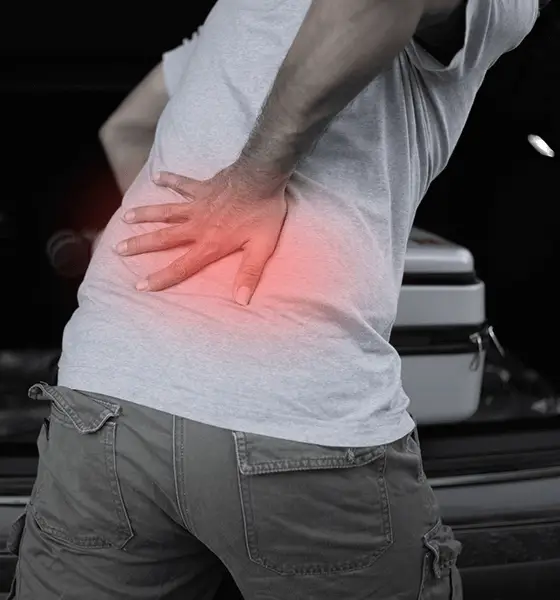Lumbar radiculopathy is a condition that occurs when the nerves that originate in the lower spine become irritated or compressed. This can cause a range of symptoms, including pain, numbness, and weakness in the lower back, hips, legs and feet.
There are several common ways that people can develop lumbar radiculopathy. One of the most frequent causes is degenerative changes in the spine. This can occur as a result of wear and tear over time, or due to injury. Herniated discs, spinal stenosis, and other conditions that affect the spine can all lead to nerve compression in the lower back.
In addition to degenerative changes, inflammation or infection in the spine can also cause lumbar radiculopathy. Certain autoimmune conditions, such as rheumatoid arthritis, can affect the spine and cause nerve compression. In rare cases, tumors can also cause lumbar radiculopathy.

The symptoms of lumbar radiculopathy can vary depending on the severity and location of the nerve compression. Some people may experience only mild discomfort, while others may experience significant pain, numbness, or weakness in the affected area. In some cases, lumbar radiculopathy can cause loss of bladder or bowel control, which can be a medical emergency.
One of the main problems associated with lumbar radiculopathy is reduced mobility. The condition can make it difficult to perform everyday activities, such as walking, standing, or sitting for extended periods of time. Chronic pain can also have a significant impact on a person’s quality of life, affecting their ability to work, socialize, or engage in physical activity.
There are several treatment options available for lumbar radiculopathy, including medications, physical therapy, and surgery. However, many people prefer to seek out non-invasive treatment options that address the underlying cause of the condition.
Chiropractic care provided by typical chiropractors can be an excellent option for those seeking non-invasive, drug-free treatment for lumbar radiculopathy. Chiropractors can use a variety of techniques to help reduce pain, improve mobility, and address the underlying causes of the condition. This may include spinal adjustments, soft tissue therapy, and exercise prescription.
One of the benefits of chiropractic care is that it focuses on healing the underlying condition, rather than just masking symptoms with medication. This can provide long-term relief from pain and other symptoms, and can help to prevent future episodes of lumbar radiculopathy.
Chiropractic care is also a safe and effective option for treating lumbar radiculopathy. It is non-invasive and does not rely on medications or surgery to manage symptoms. Instead, chiropractic care can help heal the underlying condition and provide long-term relief from pain and other symptoms.
In addition to chiropractic care, there are several other non-invasive treatment options that can be helpful for people with lumbar radiculopathy. Physical therapy can be a useful tool for improving mobility and reducing pain. In some cases, acupuncture or massage therapy may also be helpful.
Chiropractic Care Utilizing Zone Technique for Lumbar Radiculopathy
Any Zone Technique healer, including Dr. Post, knows exactly what to do for any condition walking into the office, including radiculopathy of any type including lumbar radiculopathy. Since Zone Technique is able to unlock and unleash the powerful healing ability withing your body, your healing results will be exponentially better than any other healing technique available today. Whether you have or someone else you know has lumbar radiculopathy, balancing the body by utilizing Zone Technique will heal your body on a deep level. Zone Technique healing is natural, effective, and permanent so that you will heal completely, function great and no longer have pain. You can be totally healthy again – feeling great and functioning perfectly from head to toe every day of the year!
If you don’t live close enough to see Dr. Post, search for a certified Zone Technique healer closer to you by searching the ZONE TECHNIQUE PRACTITIONER DIRECTORY. You owe it to yourself to take action so that you can heal and feel awesome again.
Overall, lumbar radiculopathy can be a challenging condition to live with. However, there are many treatment options available that can help to reduce pain and improve mobility. If you are experiencing symptoms of lumbar radiculopathy, it is important to seek treatment as soon as possible to prevent further damage to the spine and nerves. Whether you choose chiropractic care or another treatment option, taking steps to manage your symptoms can help you to get back to your normal activities and improve your quality of life.
If you are having symptoms of lumbar radiculopathy, or anything close to these symptoms, feel free to make an appointment with Dr. Post at Zumbrota Chiropractic for a free consultation or to begin treatment so that you can start feeling better as soon as possible. Life is a whole lot better when you feel great.

